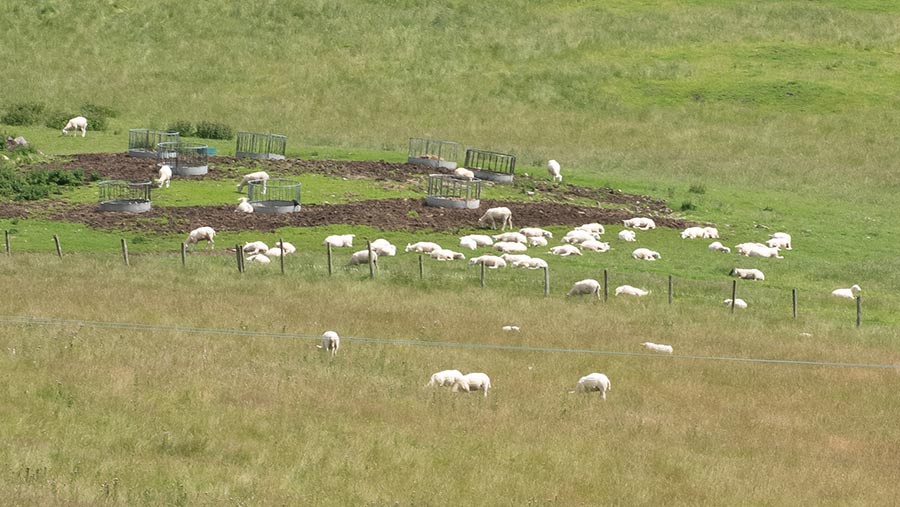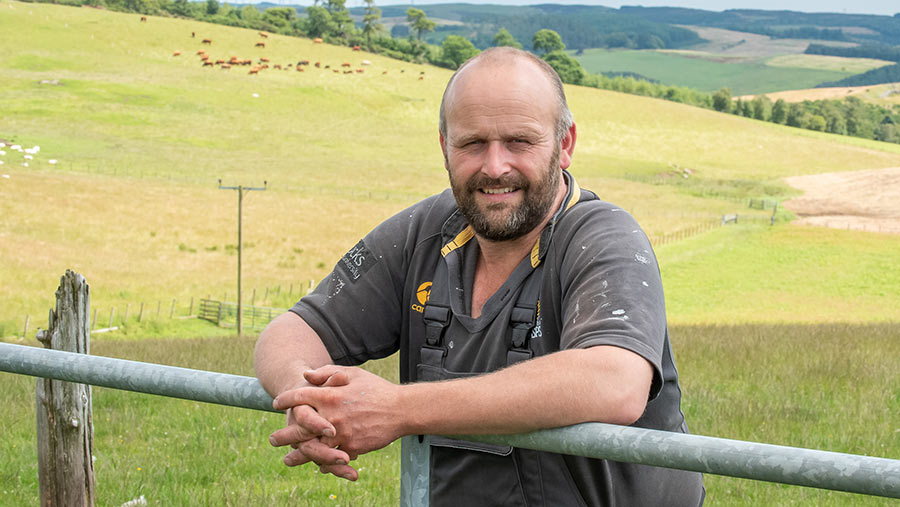How to restart rotational grazing after a wet winter
 © Angus Findlay
© Angus Findlay Beef and sheep farmer John Ritchie, winner of Farmers Weekly’s Grassland Manager of the Year 2023, replaced set stocking with rotational grazing on his Perthshire hill farm.
He will be sharing updates about his 2024 grazing season. In the first of the series, he outlines how the season has started.
See also: How to budget and allocate rotational grazing for ewes
Farm facts: Montalt Farm, Perthshire
- Farming 272ha, of which 117ha grazing platform of improved swards
- 90 paddocks of 1.3ha
- 7ha each year drilled with forage rape for outwintering and as entry to a reseed
- 120t/year of lime spread
- No fertiliser on grazing platform
- 37kg N/ha on silage fields
- 62kg N/ha on forage crops
- Grazing platform rested for 100-120 days over winter
- Average 8.2t DM/ha/year grown
- 1,000mm rainfall
- 300m above sea level
- Soils are shallow (15-18cm) over rock
- 500 Logie Hybrid ewes lambing mid-April
- 105 Salers sucklers calving from March
- Lambs sold direct
- Selling stores and breeding heifers
How is rotational grazing on a hill farm working out?
We have 12–15-year-old grassland that grows 12t/ha of dry matter (DM), and winter-grown grass in March can be 11.5-11.8 MJ/kg metabolisable energy and 22% crude protein.
That’s more than enough for a ewe with twins. We have saved concentrates and don’t have the hassle of feeding with a snacker; cows have to do it all off forage.
How is this grazing season going so far?
Good. We aim for an average farm cover (AFC) of 1,650kg DM/ha by 1 March and we started this year with 1,780kg DM/ha. Although it’s been a very wet winter, it wasn’t cold, and we had hardly any frost or snow.
We reckon we’ve grown 2kg/day. We are now trying to eat off the winter growth to get the plants stimulated and the roots growing.
We started grazing the platform with ewes on 5 March and are now on our pre-lambing rotation. The sheep spend winter off the platform on deferred grass, or on a sacrifice field with silage.

John Ritchie © Angus Findlay
Any issues?
Our biggest problem is that it is soggy underfoot. It has been continually wet since last November when we took the tups out. At the moment, we are on day shifts to avoid poaching.
Unlike dairy farms, we have no laneways. The paddocks are set up without gates, and we just drop wires.
It takes just two weeks for them to associate you and dropping wires with a fresh feed. I thought when we started eight years ago that we would need a team of dogs to move them, but that’s not been the case.
What difference is climate change making?
It means that for the past four years we have been wetter and milder in winter, with prolonged dry spells in summer: six-to-eight weeks with no rain – it’s unheard of. I don’t know how we will deal with it.
We are carrying more stock on the farm, so if it gets tight, we can sell store cattle off the platform.
We can also wean lambs early at 80 days, instead of 110 days. We have to be flexible.
How do you operate the rotation?
We do a pre-lamb rotation on day shifts around the paddocks, then we set stock about a week before lambing at four-to-five ewes to the acre (10-12 ewes a ha).
As lambing progresses, we introduce a rotation and mob up ewes and lambs after about four weeks of age. This avoids mismothering.
We then shut off ground to avoid having a flat wedge – we need to make sure we get grass growth.
The trickiest bit is to get back on the rotation. Sheep are the hardest class of stock to rotationally graze with. Tiny lambs don’t like a lot of pressure.
Sheep are selective and pick the leaf and clover, whereas a suckler cow – or growing heifers – can survive on poor-quality grazing, so they can clean up.
e have done sheep-only grazing before, but have had to reset the residual with the mower.
We find that with two days of ewes and lambs, followed by two days of cattle, we can get good residuals.
When do cattle go back on the platform?
We outwintered 75% of them on the hill, on deferred grass until new year, then on silage.
Cows have just started calving and we hope by mid-April that we can start dropping cows and calves back into the rotation. It will be purely down to ground conditions.
Our average cow mature weight is 674kg and heifers go out weighing 360-380kg.
What are your grazing plans for this year?
We have more cattle on the platform – up from 60 cows to 105 – and have slightly reduced sheep numbers – from 750 ewes to 500 – to get a better balance between leader and follower.
Our grass demand is split 30:70, sheep to cattle.
Our paddock residual averages 1,700kg DM/ha and, if we push, we can get down to 1,600kg DM/ha, though this limits production.
We could challenge cows, but it’s the time when we are trying to get them back in calf and we don’t feed concentrates.
